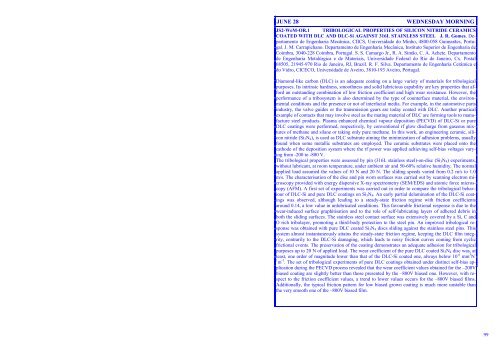Wüest M. 51 Wykes M. 82 Yamaguchi M. 17 Ybarra G. 129 Yubero F ...
Wüest M. 51 Wykes M. 82 Yamaguchi M. 17 Ybarra G. 129 Yubero F ...
Wüest M. 51 Wykes M. 82 Yamaguchi M. 17 Ybarra G. 129 Yubero F ...
You also want an ePaper? Increase the reach of your titles
YUMPU automatically turns print PDFs into web optimized ePapers that Google loves.
JUNE 28 WEDNESDAY MORNING<br />
JS2-WeM-OR.1 TRIBOLOGICAL PROPERTIES OF SILICON NITRIDE CERAMICS<br />
COATED WITH DLC AND DLC-Si AGAINST 316L STAINLESS STEEL J. R. Gomes. Departamento<br />
de Engenharia Mecânica, CIICS, Universidade do Minho, 4800-058 Guimarães, Portugal.<br />
J. M. Carrapichano. Departamento de Engenharia Mecânica, Instituto Superior de Engenharia de<br />
Coimbra, 3040-228 Coimbra, Portugal. S. S. Camargo Jr., R. A. Simão, C. A. Achete. Departamento<br />
de Engenharia Metalúrgica e de Materiais, Universidade Federal do Rio de Janeiro, Cx. Postal<br />
68505, 21945-970 Rio de Janeiro, RJ, Brazil. R. F. Silva. Departamento de Engenharia Cerâmica e<br />
do Vidro, CICECO, Universidade de Aveiro, 3810-193 Aveiro, Portugal.<br />
Diamond-like carbon (DLC) is an adequate coating on a large variety of materials for tribological<br />
purposes. Its intrinsic hardness, smoothness and solid lubricious capability are key properties that afford<br />
an outstanding combination of low friction coefficient and high wear resistance. However, the<br />
performance of a tribosystem is also determined by the type of counterface material, the environmental<br />
conditions and the presence or not of interfacial media. For example, in the automotive parts<br />
industry, the valve guides or the transmission gears are today coated with DLC. Another practical<br />
example of contacts that may involve steel as the mating material of DLC are forming tools to manufacture<br />
steel products. Plasma enhanced chemical vapour deposition (PECVD) of DLC-Si or pure<br />
DLC coatings were performed, respectively, by conventional rf glow discharge from gaseous mixtures<br />
of methane and silane or taking only pure methane. In this work, an engineering ceramic, silicon<br />
nitride (Si 3 N 4 ), is used as DLC substrate aiming the minimization of adhesion problems, usually<br />
found when some metallic substrates are employed. The ceramic substrates were placed onto the<br />
cathode of the deposition system where the rf power was applied achieving self-bias voltages varying<br />
from -200 to -800 V.<br />
The tribological properties were assessed by pin (316L stainless steel)-on-disc (Si 3 N 4 ) experiments,<br />
without lubricant, at room temperature, under ambient air and 50-60% relative humidity. The normal<br />
applied load assumed the values of 10 N and 20 N. The sliding speeds varied from 0.2 m/s to 1.0<br />
m/s. The characterisation of the disc and pin worn surfaces was carried out by scanning electron microscopy<br />
provided with energy dispersive X-ray spectrometry (SEM/EDS) and atomic force microscopy<br />
(AFM). A first set of experiments was carried out in order to compare the tribological behaviour<br />
of DLC-Si and pure DLC coatings on Si 3 N 4 . An early partial delamination of the DLC-Si coatings<br />
was observed, although leading to a steady-state friction regime with friction coefficients<br />
around 0.14, a low value in unlubricated conditions. This favourable frictional response is due to the<br />
wear-induced surface graphitisation and to the role of self-lubricating layers of adhered debris in<br />
both the sliding surfaces. The stainless steel contact surface was extensively covered by a Si, C and<br />
O rich tribolayer, promoting a third-body protection to the steel pin. An improved tribological response<br />
was obtained with pure DLC coated Si 3 N 4 discs sliding against the stainless steel pins. This<br />
system almost instantaneously attains the steady-state friction regime, keeping the DLC film integrity,<br />
contrarily to the DLC-Si damaging, which leads to noisy friction curves coming from cyclic<br />
frictional events. The preservation of the coating demonstrates an adequate adhesion for tribological<br />
purposes up to 20 N of applied load. The wear coefficient of the pure DLC coated Si 3 N 4 disc was, at<br />
least, one order of magnitude lower than that of the DLC-Si coated one, always below 10 -6 mm 3 N -<br />
1 m -1 . The set of tribological experiments of pure DLC coatings obtained under distinct self-bias application<br />
during the PECVD process revealed that the wear coefficient values obtained for the –200V<br />
biased coating are slightly better than those presented by the –800V biased one. However, with respect<br />
to the friction coefficient values, a trend to lower values occurs for the –800V biased films.<br />
Additionally, the typical friction pattern for low biased grown coating is much more unstable than<br />
the very smooth one of the –800V biased film.<br />
99
















